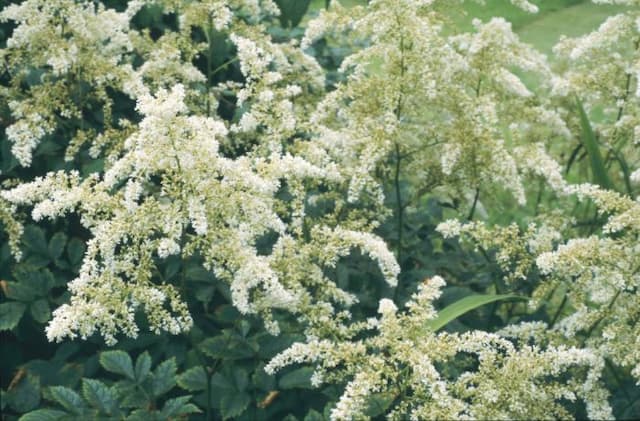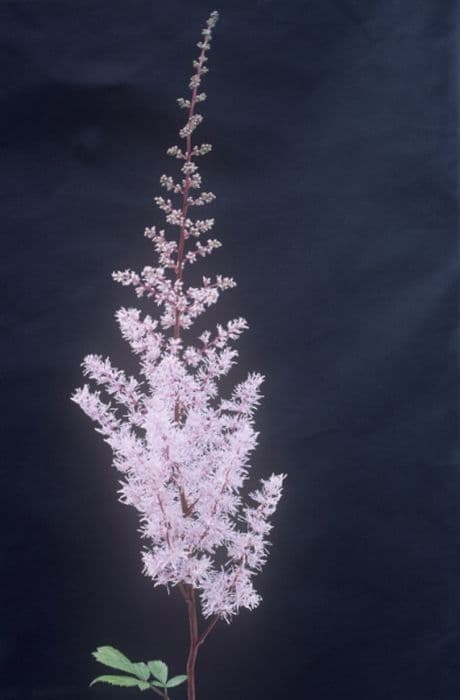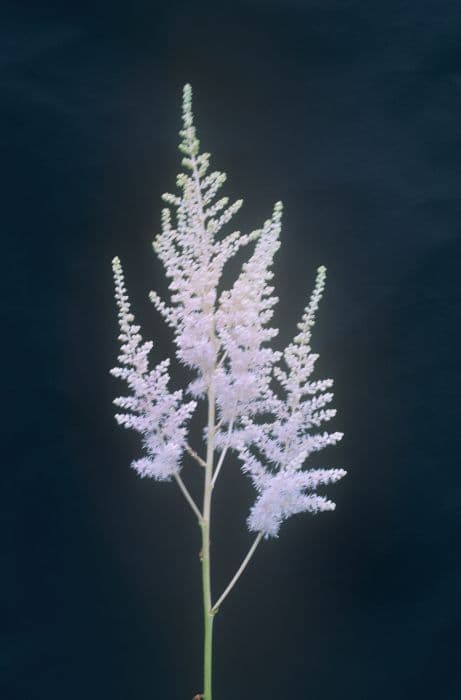Coral Bells Heuchera 'Chocolate Ruffles' (PBR)

ABOUT
Heuchera 'Chocolate Ruffles', commonly known as Coral Bells, is a striking plant celebrated for its distinct and attractive foliage. The leaves boast a rich, chocolate-brown color that can appear almost velvety, edged with ruffled margins that give the plant its name. The ruffles add a textural dimension to the foliage, with their undulating edges and tight creases reminiscent of gathered fabric. The leaf surfaces have a gently mottled pattern and often exhibit a subtle shimmer, accentuating their luxurious tone. Adding contrast to the dark leaves are the undersides, which are painted in a vibrant shade of burgundy or sometimes a deep purple, depending on the light conditions. This two-tone effect is particularly noticeable because of the plant's growth habit, as the leaves tend to arch and bend, exposing their colorful undersides. Throughout the seasons, the foliage may also transition through various shades, possibly showing hints of green or a lighter bronze, especially as the new growth emerges. The plant often forms dense, low clumps of these eye-catching leaves, creating a lush tapestry of color in garden spaces. Rising above the foliage on slender stems are delicate flower panicles. The flowers are small, bell-shaped, and often a soft, creamy white or pale pink, which creates a lovely contrast against the dramatic foliage. These blooms can add a frothy and ethereal look to the plant, especially when they sway gently in the breeze. Overall, Heuchera 'Chocolate Ruffles' presents a feast of colors and textures that can provide visual interest throughout the year, making it a popular choice for gardeners looking to add depth and elegance to their plantings. Its distinctive look helps it stand out in borders, containers, or when used as groundcover.
About this plant
 Names
NamesSynonyms
Coral Bells, Alumroot
Common names
Heuchera 'Chocolate Ruffles' (PBR).
 Toxicity
ToxicityTo humans
Coral Bells, including the variety 'Chocolate Ruffles', are generally considered non-toxic to humans. There are no well-documented cases of poisoning from ingesting this plant, and it is not typically a cause for concern if accidentally consumed in small quantities. However, as with any plant, individual reactions can vary, and it is always advisable to avoid eating ornamental plants due to possible chemical treatments or individual sensitivities.
To pets
Coral Bells are not known to be toxic to pets, including cats and dogs. If a pet ingests parts of this plant, it is unlikely to cause any serious harm. Despite its non-toxic nature, some animals might experience mild gastrointestinal discomfort if they consume large quantities of this plant, as with many non-food plants. If such symptoms occur, it is advisable to consult a veterinarian.
 Characteristics
CharacteristicsLife cycle
Perennials
Foliage type
Semi-evergreen
Color of leaves
Chocolate
Flower color
Pink
Height
1 foot 12 inches (30-45 cm)
Spread
1 foot 18 inches (30-45 cm)
Plant type
Herb
Hardiness zones
4-9
Native area
North America
Benefits
 General Benefits
General Benefits- Attractive Foliage: Heuchera 'Chocolate Ruffles' has unique and visually appealing dark leaves with ruffled edges, providing an aesthetic boost to gardens and landscapes.
- Long Season Interest: The plant offers year-round interest due to its evergreen nature and long-lasting leaf color, making it a steady feature in the garden throughout the seasons.
- Low Maintenance: It requires minimal upkeep, making it ideal for gardeners of all skill levels or those with limited time for gardening.
- Drought Tolerant: Once established, the plant is relatively drought resistant, needing less frequent watering compared to other garden plants.
- Pest and Disease Resistant: This cultivar is known for its resistance to common garden pests and diseases, reducing the need for chemical interventions.
- Versatile Landscaping Uses: Chocolate Ruffles can be used in a variety of landscape applications, including borders, groundcovers, and container gardening.
- Attracts Wildlife: The plant’s flowers can attract butterflies and hummingbirds, adding an extra layer of life and movement to the garden.
 Medical Properties
Medical PropertiesThis plant is not used for medical purposes.
 Air-purifying Qualities
Air-purifying QualitiesThis plant is not specifically known for air purifying qualities.
 Other Uses
Other Uses- Photography Prop: The rich, ruffled foliage can provide a stunning contrast in garden photography, enhancing the visual appeal of photos.
- Artistic Inspiration: Artists can draw inspiration from the intricate textures and chocolatey hues for paintings, drawings, or textile designs.
- Leaf Castings: Gardeners and crafters can use the unique leaves to make concrete or plaster castings for decorative purposes.
- Theme Gardens: Can be included in 'chocolate-themed' gardens alongside other plants with brown or dark foliage to create a unique aesthetic experience.
- Container Gardening: Its compact size and attractive leaves make it suitable for adding interest to mixed container displays on patios or balconies.
- Edging Plants: The low-growing nature of 'Chocolate Ruffles' makes it ideal for use as an edging plant along pathways or flower beds.
- Fairy Gardens: Due to its miniature and whimsical appearance, it can be used to create enchanting scenes in fairy gardens.
- Educational Tool: Can be used in schools or educational workshops to teach about plant genetics and the development of cultivars.
- Seasonal Decor: In fall, its foliage can complement pumpkins and other autumn decorations for seasonal displays or centerpieces.
- Terrariums: Suitable for incorporating into terrariums to add texture and color contrast alongside other miniature plants.
Interesting Facts
 Feng Shui
Feng ShuiThe Coral Bells is not used in Feng Shui practice.
 Zodiac Sign Compitability
Zodiac Sign CompitabilityThe Coral Bells is not used in astrology practice.
 Plant Symbolism
Plant Symbolism- Earthly Pleasures: The rich "chocolate" in the name, as well as the ruffled texture of this Heuchera, symbolize a connection to the delights of the earth and sensuality.
- Versatility: Heuchera is known for its adaptability to various garden conditions, symbolizing flexibility and the ability to thrive in different environments.
- Longevity: Being a perennial, 'Chocolate Ruffles' represents endurance and the continuation of life through the years.
- Diversity: The wide variety of colors in Heuchera leaves symbolizes diversity and the inclusion of varying perspectives and backgrounds.
 Water
WaterCoral Bells prefer consistent moisture, so water them thoroughly when the top inch of soil feels dry to the touch, which might be about once or twice a week depending on the climate and weather conditions. In hot, dry periods, more frequent watering may be necessary. It's important to provide water directly to the soil rather than overhead to minimize water on the leaves, which can lead to fungal disease. Use approximately one gallon of water per square foot every week during the growing season. Adjust the amount of water during rainy periods or as temperatures decrease to prevent waterlogging of the soil.
 Light
LightCoral Bells thrive in partial shade to full sun conditions, but in areas with hot summers, they fare best with more shade to protect their foliage. The ideal spot for Coral Bells is one that receives morning sunlight and afternoon shade, ensuring that the delicate leaves are sheltered from the intense midday sun.
 Temperature
TemperatureCoral Bells are hardy and can tolerate a wide range of temperatures, from about 25 degrees to 80 degrees Fahrenheit, but they grow best in temperatures between 60 and 70 degrees Fahrenheit. Avoid placing them in locations where winter temperatures frequently drop below 25 degrees Fahrenheit without adequate snow cover or mulch to protect them.
 Pruning
PruningCoral Bells benefit from pruning to remove any dead or damaged leaves and to encourage a tidier growth habit. Prune in the early spring or after flowering to maintain the plant's vigor and appearance. Deadheading spent flowers can also prolong blooming and prevent self-seeding.
 Cleaning
CleaningAs needed
 Soil
SoilCoral Bells favor a well-draining soil mix with plenty of organic matter, such as a blend of loam, peat moss, and perlite. A slightly acidic to neutral pH of 6.0 to 7.0 is ideal for 'Chocolate Ruffles' to thrive.
 Repotting
RepottingCoral Bells typically require repotting every 3-4 years to refresh the soil, as they are relatively slow growers. Repot 'Chocolate Ruffles' in spring before the onset of rapid growth.
 Humidity & Misting
Humidity & MistingCoral Bells prefer average humidity conditions; they do well in the typical humidity levels found in most home landscapes without the need for additional humidity adjustments.
 Suitable locations
Suitable locationsIndoor
Place in well-lit area, avoid direct sun, use well-draining soil.
Outdoor
Partial shade, well-drained soil, mulch to retain moisture.
Hardiness zone
4-9 USDA
 Life cycle
Life cycleHeuchera 'Chocolate Ruffles', commonly known as Coral Bells, begins its life as a seed, germinating in warm soil conditions often in late spring or early summer. As a juvenile, it develops a rosette of ruffled, chocolate-colored leaves from which it derives its name. As the plant matures, it produces tall, slender stems topped with delicate bell-shaped flowers, typically in shades of pink or white, by midsummer. After flowering, seeds are formed and dispersed, capable of generating new plants. Throughout the growing seasons, this perennial plant grows and expands, going dormant in the winter before resurfacing in spring. It can live for several years, gradually forming larger clumps through vegetative propagation and crown division.
 Propogation
PropogationPropogation time
Late spring to early summer
The most popular method for propagating Heuchera 'Chocolate Ruffles', also known as Coral Bells, is through division. This is ideally done in the spring or early fall. To propagate by division, carefully dig up the entire plant, ensuring that you keep as much of the root system intact as possible. Then, using your hands or a sharp, clean knife, gently separate the plant into smaller clumps, each with several shoots and a healthy portion of roots. Replant the divisions immediately at the same depth they were growing before, and water well to settle the soil around the roots. Divisions should be spaced about 12 inches (roughly 30 centimeters) apart to allow sufficient room for growth. Ensure good care following division by keeping the soil consistently moist while the new plants establish.









